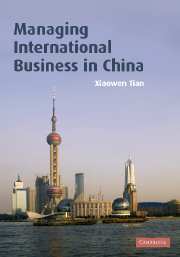Book contents
- Frontmatter
- Contents
- List of figures
- List of tables
- List of boxes
- Preface
- 1 Introduction
- 2 Look before you leap
- 3 Manage guanxi strategically
- 4 Select an entry mode
- 5 Form an alliance
- 6 Negotiating with Chinese partners
- 7 Production operations management
- 8 Marketing management
- 9 Human resource management
- 10 The protection of intellectual property rights
- 11 Corporate finance considerations
- References
- Index
- References
11 - Corporate finance considerations
Published online by Cambridge University Press: 05 June 2012
- Frontmatter
- Contents
- List of figures
- List of tables
- List of boxes
- Preface
- 1 Introduction
- 2 Look before you leap
- 3 Manage guanxi strategically
- 4 Select an entry mode
- 5 Form an alliance
- 6 Negotiating with Chinese partners
- 7 Production operations management
- 8 Marketing management
- 9 Human resource management
- 10 The protection of intellectual property rights
- 11 Corporate finance considerations
- References
- Index
- References
Summary
The government has already proposed measures to improve corporate governance and address the cost and priorities for enhancing a financial system appropriate for the potentially largest economy of the twenty-first century. It is important to acknowledge that the financial and governance arrangements that ultimately emerge in China will surely be unique. After all, the legacy of China's social, economic, and political systems is embedded in a history that has seen several waves of sweeping change since the People's Republic of China was founded in 1949 (Chris Gentle (2005, p. 69)).
Since China began to reform and open up in 1978, and particularly since WTO accession in 2001, China's financial system and corporate finance structure have undergone fundamental changes. However, they are still different from those in most other parts of the world in many respects, including taxation, banking services, the securities market, accounting and auditing. Transnational corporations need to understand the differences, and learn how to manage corporate finance in China. In this chapter we discuss some of the most important issues that TNCs have to take into account in corporate finance management in China. First we discuss China's taxation arrangement for foreign affiliates in section 1, and the banking services available to foreign affiliates in section 2. Then, in sections 3 and 4, we discuss Chinese securities market and accounting practices in relation to the operation of foreign affiliates, respectively. The final section summarizes.
- Type
- Chapter
- Information
- Managing International Business in China , pp. 253 - 277Publisher: Cambridge University PressPrint publication year: 2007



